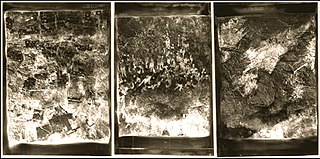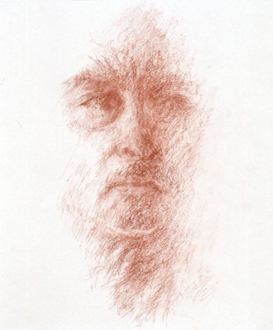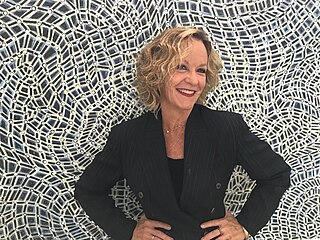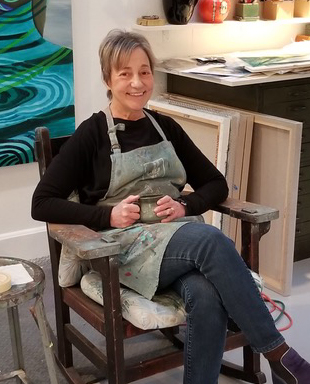
Ruth Bernhard was a German-born American photographer.
Jane L. Calvin is an artist based in Chicago, Illinois.
The New Art Examiner was an international magazine of critical art thinking founded in Chicago, Illinois, in October 1973 by Derek Guthrie and Jane Addams Allen. Publication ceased in 2002. As of 2023 there are two publications using the name and styling of the New Art Examiner. It officially relaunched in 2015 (Chicago) but there was a dispute/split between editors Derek Guthrie and Michel Segard in 2017. The U.S.-based "New Art Association" trademarked the name "New Art Examiner" in 2019; in 2021, a U.S. court ruled that the U.S. operation (.org) owns the New Art Examiner trademark and logo in the United States; the trademark dispute has not been similarly tested in a United Kingdom court. As of 2023, New Art Examiner (.net) is based in the United Kingdom. An anthology of representative articles and editors from New Art Examiner, Essential New Art Examiner, was published in 2011.
Jane Fulton Alt is an American photographer who explores issues of love, loss, and spirituality in her work. Alt was the recipient of the 2007 Illinois Art Council Fellowship Award and the 2007, 2008 and 2009 Ragdale Fellowship Award.

Barbara DeGenevieve (1947–2014) was an American interdisciplinary artist who worked in photography, video, and performance. She lectured widely on her work and on subjects including human sexuality, gender, transsexuality, censorship, ethics, and pornography. Her writing on these subjects have been published in art, photographic, and scholarly journals, and her work has been exhibited internationally.

Bea Nettles is a fine art photographer and author currently residing in Champaign/Urbana, Illinois.
Douglas Ischar is an openly gay, American artist known for his work in documentary photography, installation art, sound art and video art addressing stereotypes of masculinity and male behavior. He currently lives and works in Chicago, where he teaches art at the University of Illinois at Chicago. Ischar serves on the curatorial board of Chicago's Iceberg Projects, a not-for-profit experimental exhibition space.

Phyllis Bramson is an American artist, based in Chicago and known for "richly ornamental, excessive and decadent" paintings described as walking a tightrope between "edginess and eroticism." She combines eclectic influences, such as kitsch culture, Rococo art and Orientalism, in juxtapositions of fantastical figures, decorative patterns and objects, and pastoral landscapes that affirm the pleasures and follies of romantic desire, imagination and looking. Bramson shares tendencies with the Chicago Imagists and broader Chicago tradition of surreal representation in her use of expressionist figuration, vernacular culture, bright color, and sexual imagery. Curator Lynne Warren wrote of her 30-year retrospective at the Chicago Cultural Center, "Bramson passionately paints from her center, so uniquely shaped in her formative years […] her lovely colors, fluttery, vignette compositions, and flowery and cartoony imagery create works that are really like no one else's. Writer Miranda McClintic said that Bramson's works "incorporate the passionate complexity of eastern mythology, the sexual innuendos of soap operas and sometimes the happy endings of cartoons."
Barbara Crane was an American artist photographer born in Chicago, Illinois. Crane worked with a variety of materials including Polaroid, gelatin silver, and platinum prints among others. She was known for her experimental and innovative work that challenges the straight photograph by incorporating sequencing, layered negatives, and repeated frames. Naomi Rosenblum notes that Crane "pioneered the use of repetition to convey the mechanical character of much of contemporary life, even in its recreational aspects."

Silvia A. Malagrino is an American multimedia artist, independent filmmaker and educator based in Chicago, Illinois. She is known for interdisciplinary work that explores historical and cultural representation, and the intersections of fact, fiction, memory and subjectivity. Her experimental documentary, Burnt Oranges (2005), interwove personal narrative, witness testimony, interviews, and both documentary and re-created footage to examine the long-term effects of Argentina's Dirty War. Malagrino's art has been featured at The Art Institute of Chicago, Palais de Glace and Centro Cultural Recoleta, La Tertulia Museum, Museum of Contemporary Photography of Columbia College Chicago, Chicago Cultural Center, Rochester Institute of Technology, Center for Photography at Woodstock, and Ateneo de Madrid, among other venues. Her work has been recognized by institutions including the Guggenheim Foundation CINE, the Smithsonian Institution, and Bibliothèque nationale de France. Malagrino is Professor in Photography and Moving Image at the School of Art and Art History of the University of Illinois at Chicago.
Myra Greene is an American artist who has worked on a number of projects, mostly photographic. Among them are Hairy Projects, The Beautiful Ones, Character Recognition, Self Portraits, My White Friends, and Sketches for Something.

Joanna Frueh (1948–2020) was an American artist, writer, and feminist scholar.
Holly Roberts is an American visual artist known best for her combination of photography and paint. “Holly Roberts caused a stir in the fine art photography world of the eighties by fusing painting and photography, painting directly onto photographs”. Roberts lives and works in Corrales, New Mexico. Her work is in the permanent collection of several museums in the United States.

Arthur Lerner is an American artist, known for his atmospheric figurative paintings and drawings, landscapes, and still lifes. He is sometimes described as a realist, but most critics observe that his work is more subjective than descriptive or literal. Associated with Chicago's influential "Monster Roster" artists early in his career, he shared their enthusiasm for expressive figuration, fantasy and mythology, and their existential outlook, but diverged increasingly in his classical formal concerns and more detached temperament. Critics frequently note in Lerner's art a sense of light that evokes Impressionism, delicate color and modelling that "flirts with dematerialization," and the draftsmanship that serves as a foundation for all of his work. The Chicago Tribune's Alan Artner lamented Lerner's comparative lack of recognition in relation to the Chicago Imagists as the fate of "an aesthete in a town dominated by tenpenny fantasts." Lerner's work has been extensively covered in publications, featured in books such as Monster Roster: Existential Art in Postwar Chicago, and acquired by public and private collections, including those of the Smithsonian Institution, Art Institute of Chicago, Smart Museum of Art, and Mary and Leigh Block Museum of Art, among many.

Susan Sensemann is an American artist, educator and arts administrator, best known for her detailed, largely abstract patterned paintings and photomontages reflecting gothic, baroque, spiritual and feminist sensibilities. She has exhibited her work at venues including the Art Institute of Chicago, A.I.R., The Living Art Museum (Reykjavík), Indianapolis Art Center, Chicago Cultural Center, and Art Institute of Boston, on four continents. Her work has been widely reviewed and resides in numerous private, university and corporate collections. Sensemann is known as a versatile and prolific creator, whose ideas have led her to explore diverse painting materials, media, subject matter, and styles from abstraction to realism. Critics note her work's densely packed compositions, shallow fields of oscillating space, complex tactile surfaces, and sensuous color and linearity. James Yood wrote that Sensemann's abstract paintings were "fraught with meaning, charged with value, and seething with import" in their spiritual seeking. Art historian Leisa Rundquist described her photomontage self-portraits as "strangely sensual, yet disturbing" images drawn from "the depths of the unconscious."

Alison Ruttan is an American interdisciplinary artist whose work investigates human behaviors such as appetite, sexuality and aggression and the degree to which they are governed by biology or social conditioning. She has explored diverse media from animation to photography to installation and drawn on fields from primatology to social theory, creating work that ranges from light-hearted gender critique to sobering meditation on war. Ruttan has exhibited individually at the Chicago Cultural Center, Hyde Park Art Center, Three Arts Club of Chicago and Monique Meloche Gallery, and in group shows at the Museum of Contemporary Photography, The Drawing Center, Crystal Bridges Museum of American Art, Apexart and Minneapolis Institute of Art, among many venues. She has also shown internationally at Directors Lounge (Berlin) and in Canada, the Netherlands, Russia, Spain and the United Kingdom. Her work has been discussed in journals such as Art in America, Flash Art, Art Papers, Sculpture, and New Art Examiner, as well as in major newspapers, magazines, and television and radio outlets. In addition to her art career, Ruttan has taught at several Chicago institutions, most notably the School of the Art Institute of Chicago. She has been based in Chicago with her husband, artist Scott Stack, since 1990.

Barbara Grad is an American artist and educator, known for abstract, fractured landscape paintings, which combine organic and geometric forms, colliding planes and patterns, and multiple perspectives. Her work's themes include the instability of experience, the ephemerality of nature, and the complexity of navigating cultural environments in flux. While best known as a painter, Grad also produces drawings, prints, mixed-media works and artist books. She has exhibited in venues including the Art Institute of Chicago, Kemper Museum of Contemporary Art, Danforth Art, Rose Art Museum, Indianapolis Museum of Art and A.I.R., and been reviewed in publications, including Artforum, Arts Magazine and ARTnews. Grad co-founded Artemisia Gallery, one the country's first women-artist collectives, in Chicago in 1973. She has been an educator for over four decades, most notably at the Massachusetts College of Art and Design. Grad has been based in the Boston area since 1987.
Deborah Bright is a 20th-century American photographer and artist, writer, and educator. She is particularly noted for her imagery and scholarship on queer desire and politics, as well as on the ideologies of American landscape photography. Her work is in the collections of the Smithsonian American Art Museum, the Fogg Art Museum, and the Whitney Museum of American Art. Bright's photographic projects have been exhibited internationally.
Artemisia Gallery was an alternative exhibition space in Chicago, Illinois, United States, that operated from 1973 until its closure in 2003.

Jane Wenger is an American artist known for black-and-white photography of abstracted human forms. Her work has been described as intense, visceral and enigmatic. It captures the body in intimate close-up, often during moments of extreme physical tension, in compressed compositions with minimal context. Wenger has exhibited at MoMA PS1, Museum of Contemporary Art, Chicago (MCA), Museum of Fine Arts, Houston, and the Milwaukee Art Museum. Her photographs belong to the collections of the Museum of Modern Art, MCA Chicago, Museum of Contemporary Photography and Indianapolis Museum of Art, among others.















